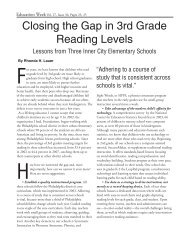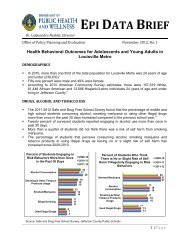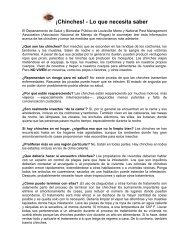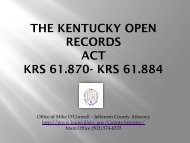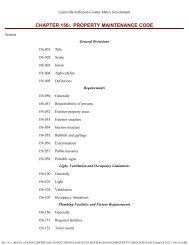Cultural History of Charlie Vettiner Park - Louisville Metro Government
Cultural History of Charlie Vettiner Park - Louisville Metro Government
Cultural History of Charlie Vettiner Park - Louisville Metro Government
Create successful ePaper yourself
Turn your PDF publications into a flip-book with our unique Google optimized e-Paper software.
<strong>Cultural</strong> <strong>History</strong> <strong>of</strong> <strong>Charlie</strong> <strong>Vettiner</strong> <strong>Park</strong><br />
Northern Riverine Forests would have been present (Kricher 1988:72). Oak-Hickory Forests<br />
commonly contain a wide variety <strong>of</strong> flora. The trees that may have been present historically<br />
include a different species <strong>of</strong> oaks and hickories, American chestnut, dogwood, sassafras,<br />
hophornbeam, and hackberry. Tuliptrees, elm, sweetgum, shagbark hickory, and red maple also<br />
may have been present, especially in moist areas. The understory may have contained<br />
mountain laurel, a variety <strong>of</strong> blueberries, and deer berry among other plants. Herbs may have<br />
included wintergreen, wild sarsaparilla, wood-sorrel, mayapple, rue-anemone, jack-in-the-pulpit,<br />
and trout lilies to name a few (Kricher 1988:57).<br />
A wide variety <strong>of</strong> fauna would also have been present from the early Holocene to early historic<br />
times. Mammals that thrived in Oak-Hickory Forests may have included the gray squirrel, fox<br />
squirrel, whitetail deer, raccoon, beaver, woodchuck, a variety <strong>of</strong> mice, striped skunks, mink,<br />
otter, fox, black bear, and bobcats. Bird species would likely have included red-tailed hawks,<br />
ruffed grouse, great horned and eastern screech owl, pileated woodpecker, wild turkeys, and<br />
blue jay among others (Kricher 1988:12). A variety <strong>of</strong> ducks and geese also could have been<br />
present during the Fall and Spring migrations.<br />
Climate<br />
Today, Kentucky has a temperate climate. Jefferson County has a wide range in temperature,<br />
rainfall, wind, and humidity throughout all seasons. In the county, the temperature rises to 90<br />
degrees or higher on about 49 days in an average year, while a temperature <strong>of</strong> 100 degrees is<br />
reached only once a year in June, July, August or September. Freezing temperatures occur on<br />
about 92 nights an average winter and a daily freeze-thaw cycle is normal for cold weather. The<br />
average length <strong>of</strong> the growing season for the county, from the last light freeze in spring to the<br />
first light freeze in the fall, ranges from 200 days in the western part <strong>of</strong> the county to 175 days in<br />
the eastern part <strong>of</strong> the county. The average annual rainfall for Jefferson County is 41.32 inches<br />
with the wettest month being March averaging 4.59 inches <strong>of</strong> rain (Zimmerman 1966:131). The<br />
driest month <strong>of</strong> the year in Jefferson County is October with only 2.25 in falling on average.<br />
Prehistoric <strong>Cultural</strong> Context<br />
<strong>Cultural</strong> change is a slow and continual process; therefore, archaeologists typically divide the<br />
long period <strong>of</strong> human history into regionally distinct cultural periods. As discussed below,<br />
archaeologists recognize four broadly defined prehistoric periods for the Eastern Woodlands.<br />
The sections below review the prehistoric cultural groups that may have been present in the<br />
project APE over the past 12,000 years. Each group occurred during specific periods <strong>of</strong> time<br />
and generally ranged across the Eastern North American woodlands. The temporal and regional<br />
variants within the Falls region, however, must still be discovered, analyzed and interpreted.<br />
Data recovered during the present project will aid these investigations. Overall, trends evident<br />
from the earliest (Paleoindian) to the latest (Mississippian) period include an increase in<br />
sedentism, increase in social complexity, and increase in dependence on agriculture. These<br />
trends have been explored by many in the social sciences such as Lewis Morgan, Leslie White,<br />
and Robert Wright (Wright 2000).<br />
Paleoindian Period (10000 to 8000 B.C.)<br />
Although the lithic material associated with Paleoindians is the earliest dated material recovered<br />
from humans in North America, it is also one <strong>of</strong> the most impressive. As with many cultural<br />
adaptations, the technology and the Paleoindians themselves had a long history <strong>of</strong> evolution in<br />
10 | P a g e



